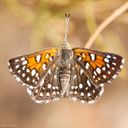Hodges#4402
Apodemia mormo
Classification
- Phylum: Arthropoda
- Subphylum: Hexapoda
- Class: Insecta
- Order: Lepidoptera
- Superfamily: Papilionoidea
- Family: Riodinidae
- Subfamily: Riodininae
- Tribe: Emesidini
- Genus: Apodemia
- Species: mormo
Pronunciation
How to pronounce Apodemia mormo: /ˌæpəˈdiːmiə ˈmɔːrmoʊ/
These audio files are automatically generated. While they are not always 100% accurate, they are a good starting point.
Images






Summary
Apodemia mormo, known as the Mormon metalmark, is a butterfly found mainly in western North America. Its populations exhibit notable ecological and morphological variations influenced by habitat, location, and host plant availability, leading to diverse taxonomic classifications. Conservation efforts are in place for certain populations that face threats from human activities and habitat loss.
Physical Characteristics
Wingspan of 25–35 mm, males slightly smaller than females, with females possessing three pairs of functional legs while males have reduced forelegs. The Canadian populations have white checked dark brown wings, a gray body, green eyes, and black and white banded antennae, with reddish tint towards the base of the forewings and gray ventral sides.
Identification Tips
Hind wing with little or no orange coloring above, typically concentrated toward the base. Median row of white spots set on a dark background, often edged in black.
Habitat
Primarily occupy dry, arid habitats that support high density of larval host plants, including dunes, sloping hillsides, grasslands, and gravelly deserts. Microhabitat characteristics include lower elevation, a southerly aspect, and high soil pH.
Distribution
Western North America, ranging from Sinola, Mexico to Southwestern Canada, primarily in California, Utah, Arizona, New Mexico, and Washington. Canadian populations in British Columbia (endangered) and Saskatchewan (threatened).
Diet
Larval host plants are various species of Eriogonum (buckwheat). Adults prefer Eriogonum flowers for nectar, with rabbitbrush (Ericameria nauseosus) as a secondary source.
Life Cycle
Eggs are clustered and may vary in color between populations. Larvae remain on a single host plant; early instars hibernate. Pupation occurs in leaf litter, with adult emergence spread over a month.
Reproduction
Mating occurs three days into adult lifespan; oviposition behavior varies, with females laying eggs near host plants.
Predators
Trichogramma kaykai, a parasitic wasp, preys on the eggs of A. mormo deserti.
Conservation Status
British Columbia population is endangered, Saskatchewan population is threatened. Conservation efforts initiated due to habitat specificity and vulnerability.
Ecosystem Role
Pollinator in arid ecosystems, closely linked to specific host plants.
Misconceptions
Confusion about the classification of subspecies and species within the mormo complex, with variability in recognition among authors.
Tags
- butterfly
- Lepidoptera
- Riodinidae
- conservation
- habitat
- species complex